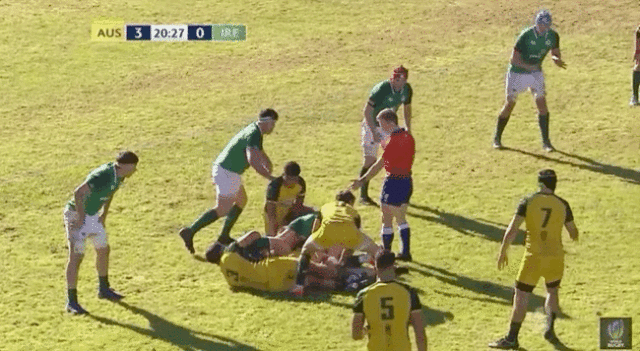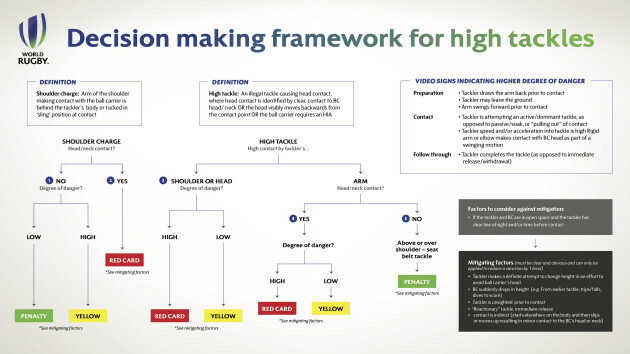IT’S A NIGHTMARE scenario for any of the players, coaches or supporters involved in the World Cup.
In a key game, a high tackle decision going against their team. Yellow card. Even worse, a red card that could be truly decisive in the outcome of a vital fixture.
Joe Schmidt’s Ireland have had Alain Rolland – referee of the 2007 World Cup final and now World Rugby’s ‘high-performance match officials manager’ – into their pre-World Cup training camp to ensure they are as well-prepared as possible to avoid this pain.
Anyone who has been watching rugby in recent years will be well aware that the game has been attempting to clamp down on high tackles more severely, with World Rugby driving a bid to reduce concussion in the sport. Such a focus has been hugely welcome.
Based on its own in-depth analysis, the game’s governing body has been on a mission – involving increased sanctions and various trials – to change the behaviour of tacklers, striving to get them to lower their body height.
There have been some positive results but World Rugby has been concerned that referees are still not punishing dangerous high tackles severely and consistently enough.
And so we have arrived at the new high tackle framework, which World Rugby hopes will provide a clearer, step-by-step process for referees to ensure they make the right decisions around high tackles and shoulder charges more consistently.
The framework aims to clearly define what high tackles and shoulder charges are, then help referees through the process of deciding whether the sanction should be a penalty, yellow card or red card.
That the framework was brought in with immediate effect at the end of May, less than four months before the start of the World Cup, shows World Rugby are serious about this.
So, will the framework change much?
The World Rugby U20 Championship in June allowed us first view of the new framework in action, with the players at the Argentina-hosted competition essentially serving as the guinea pigs.
In total, there were 14 yellow cards and four red cards for high tackles and shoulder charges during the championship.
This was a notable increase on 2018 when there were 10 yellow cards and one red card.
Go back to 2017 and there were just two yellow cards and one red card for high tackles.
World Rugby will point out that 18 of the 30 games at this year’s championship in Argentina had no cards for high tackles at all, so fears that every fixture would be affected by players being sin-binned or sent off proved unfounded.
Encouragingly for World Rugby, the rate of penalties per card was reduced from 3.2 to 2.7 this year – essentially meaning that referees now appear more likely to dish out a card for a high tackle offence deserving of that sanction.
Best of all, World Rugby has recorded a 30% reduction in the incidence of concussion over the last two years of the U20 Championship, although it is too early to claim that reduction is only because of the increased focus on high tackles.
This summer’s U20 Championship was not without frustrations for the players and coaches involved.
Match officials often took extended periods of time to go through the framework procedure – they weren’t helped by the in-venue screens being smaller – while there was still disagreement on the actual decisions, as well as some inconsistency.
In a particularly interesting case, Ireland’s highly-talented Ryan Baird was red-carded for a challenge on an Australian player. Baird’s own reaction after tackling Will Harrison suggested that he felt a severe sanction was on the way.
Click here if you cannot view the clip above
Referee Christoper Ridley reviewed the incident in some depth with his TMO and eventually ruled that “there was clear, direct contact to the neck” with “a high level of danger”. The referee didn’t find any mitigation, resulting in his red card decision.
A disciplinary committee subsequently stated that the initial contact in Baird’s challenge had been to the Australian player’s shoulder before slipping up to make neck/head contact, and had therefore been “indirect”.
While the disciplinary committee didn’t state that Baird should have been yellow carded – their final ruling was “sending off sufficient” – the report did say the committee had found Ireland’s argument that Baird’s actions only warranted yellow “convincing”.
This apparent confusion and disjoint between referee and the disciplinary committee was partly responsible for World Rugby quietly making a change to its framework, just a month after first releasing it to the public.
The change means that ‘direct/indirect’ has been removed from the step-by-step part of the process.
The definition of a high tackle has also seen the word ‘direct’ removed, while ‘indirect contact’ is now included among the possible mitigating factors.
World Rugby is hopeful that the process will now be clearer and easier for referees [and disciplinary committees] to follow.
Some of those involved in the U20 Championship had concerns that any room for match officials to apply their own feel for incidents and games has now been completely removed and they will be forced to hand out punishments they may not believe fit the crime.
Others will say that’s a good thing – taking away the emotive element of decisions.
The 23 match officials who will be involved in the World Cup have been educated in the framework and will have reviewed incidents at the U20 Championship as they get set to ensure illegal high tackles and shoulder charges are strongly sanctioned in Japan.
It will be interesting to note how this aspect of World Cup warm-up games plays out, with a high tackle yellow card shown in last weekend’s Rugby Championship clash between South Africa and New Zealand, when André Esterhuizen made a challenge on Tom Banks.
Referee Paul Williams did not vocally deal with each step of the framework as he went through the video review process but indicated that “the player with the ball was actually quite low. Yes, the contact is around the head. It’s going to be a yellow card.”
Click here if you cannot view the clip above
There was no reference to the ‘degree of danger’ or ‘aggravating factor,’ which are part of the framework, so it would be interesting to hear Williams talk through his sense of the incident with those elements accounted for.
It would certainly be helpful for supporters, players and coaches to hear referees talk their way through each step of the process given that World Rugby wants officials to refer to the framework.
Of course, we don’t want the game slowed down any further but it would take only seconds to help increase familiarity with the process.
Now we wait to see how referees handle similar incidents in the coming weeks and months, with the message being extremely clear to players and coaches – high tackles will be punished more severely than at any World Cup before.
There have been only 17 red cards in total at the previous eight versions of the tournament – for all offences, not just dangerous tackles - and the hope is obviously that no referee is required to send a player off in Japan.
Indeed, the hope is that high tackle offences are not decisive in any games at all, even if that seems unlikely.
In the event that any of their players do infringe, the smartest coaches will surely have their teams better prepared than ever for the prospect of playing with reduced numbers on the pitch.
More than anything, the hope is that the measures World Rugby has taken in recent years and months ensure that concussion rates are lower than ever as the best players in the game collide.
The42 is on Instagram! Tap the button below on your phone to follow us!





